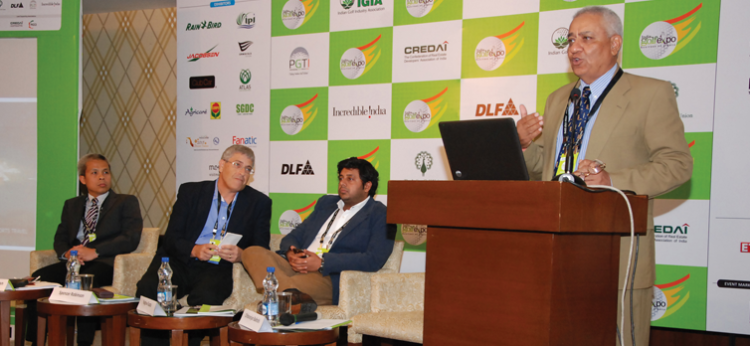It is probably an irony filled with profound import. Every year, thousands of golfers from Europe overfly the Indian sky to land in Thailand – the new golfing powerhouse in the world today. In terms of sheer volume of golf courses, there isn’t much of a difference between India and Thailand.  While the Indian map is today dotted with around 228 golf courses, in Thailand the number is slightly higher at 240. But the difference lies in the approach, the attitude and the strategy. Spotting the rising tide in the golf tourism stream 20 years back, Thailand has meticulously placed itself in the list of top golfing destinations in the world. Last year, the country saw arrival of a staggering 8 lakh golf tourists from distant corners of the world. As against this, the Indian golf tourism scenario does not have much to write home about. Talk to anybody in the golf tourism trade today and he will tell you that the number of international golf centric arrivals in India is no more than a couple of thousands (based on the sales figure of specific golf tourism packages which Indian golf tourism operators offer). “There is no doubt that the potential in golf tourism segment is immense. But we haven’t exactly even started in the real sense of the term,” says Rishi Narian, MD, RN Sports Marketing. “For past five years, we have been talking of potential. But where is the change on the ground?” rues Col. S K Sinha, Chief General Manager, Aamby Valley City.
While the Indian map is today dotted with around 228 golf courses, in Thailand the number is slightly higher at 240. But the difference lies in the approach, the attitude and the strategy. Spotting the rising tide in the golf tourism stream 20 years back, Thailand has meticulously placed itself in the list of top golfing destinations in the world. Last year, the country saw arrival of a staggering 8 lakh golf tourists from distant corners of the world. As against this, the Indian golf tourism scenario does not have much to write home about. Talk to anybody in the golf tourism trade today and he will tell you that the number of international golf centric arrivals in India is no more than a couple of thousands (based on the sales figure of specific golf tourism packages which Indian golf tourism operators offer). “There is no doubt that the potential in golf tourism segment is immense. But we haven’t exactly even started in the real sense of the term,” says Rishi Narian, MD, RN Sports Marketing. “For past five years, we have been talking of potential. But where is the change on the ground?” rues Col. S K Sinha, Chief General Manager, Aamby Valley City.
On the sidelines of the recently held Indian Golf Expo (in Gurgaon), some senior stakeholders of the industry indulged in a thread bare discussion and the uniform voice popping out of the seminar clearly underlined that Indian golf tourism has miles to go even as there are some favourable trappings – the country has about 30 golf courses at par with international standards, the number of golfers is rising in the country and that there is perceptible swing in favour of Asia where the sport is gaining popularity at a rapid face. But then these supporting elements have not surfaced suddenly, out of nowhere. Rather they have been in existence for quite sometime (something which a country like Thailand was quite agile to trace). And, therefore, the basic issue now for Indian golf tourism stakeholders is: how to shift gears and make it work?
Global scenario: Asia becoming the new hub of Golf Tourism
Statistics clearly reveal that financial turbulence of the last decade which impacted the major developed markets did not exactly chuck a spanner in the wheels of golf tourism. Its growth has rather been consistent and there has been a subtle addition of a major sub-plot in terms of some Asian countries becoming the new hotspots. “Golf Tourism has arrived in a major way on the international scene and today it is a multi-billion dollar industry. In the last two years, we have seen a major surge of 20 percent in golf tourism packages sales by the operators. Some Asian countries like Thailand, Indonesia and even Vietnam have made major headway in this segment wherein a golf tourist spends three times more than any other regular international tourist. A country like Indonesia is now talking of earning foreign exchange in the range of $600 million by promoting golf tourism,” Spencer Robinson, Chief Communications Officer, Asian Golf Industry Federation commented.
Some basic numbers further elaborate the spreading wings of the golf industry and the expansion of its obvious off-shoot – golf tourism. According to an industry estimate, there are about 56 million golfers in the world with the US market having a lion’s share of 30 million. The next big chunk of golf enthusiasts come from the European nations. Out of 56 million golfers, about 10 percent visit exotic international locations to make their sporting experience all the more memorable. It is this group of 5.6 million golfers who are at the fulcrum of international golf tourism which make it a $20 billion industry today. With nearly a 25 million golfing population, the US also leads the pack in terms of golf courses volume which is close to 16,000. Japan, in Asia, boasts a significant golfing population of around eight million (with 2349 golf courses). The sport is equally strong in most of the major European markets like the UK, Germany, France and Spain and also in relatively smaller markets like Ireland. The prominent names in the list of the major global golf tourism destinations are: Spain (1 million footfall annually), Thailand (8,00,000) and Turkey (5,00,000).
While the US and the European nations have dominated the sport in the past, all projections are pointing in the direction of some Asian countries picking up major strength fuelled by their rising affluence. China and India are the two major names in the mind of everybody especially in terms of a significant enhancement in the volume of golf enthusiasts. A report released by HSBC in 2012 had clearly earmarked that the sport and its allied activities will get major push from these two rising economic giants. “In Asia, the growing middle class is taking to golf in increasing numbers, as a leisure pursuit and as a sign of status. As China and India get richer, this growth seems certain to increase. Between 2010 and 2020, Asia is expected to double its share of global middle class consumption to 42%. By 2015, 98 million Chinese households are expected to be middle-class, compared with 52 million in 2010. India’s middle class is estimated to grow from 32 million households in 2010 to more than 50 million by 2015. With increasing incomes and the more widespread acquisition of luxury brands comes the drive to set oneself apart from others – making leisure experiences such as international travel and sporting expertise highly sought after as status symbols,” the report had observed.
The success notched by Thailand, Indonesia and also Vietnam in promoting their golf tourism assets in some way endorse the fact that Asia is the new hub of golf tourism. Apart from Europe, Japan and China, Thailand these days have also begun witnessing a rise in golf tourist footfall from India which is nearly 4 percent of its total golfing traffic presently. The moot point here is: why has India lagged behind in harnessing its golf tourism assets? Equally important is: what will it take to join the global golf mainstream?
Cracking the code in golf tourism
The Indian golf tourism stakeholders may be voicing their fault finding assumptions differently but their viewpoints veer round to the same conclusion – lack of focus and, therefore, lack of an integrated approach have been the major stumbling blocks. This despite the fact that India has 228 golf courses and the domestic golfing population is in the range of 125,000 which has shown consistent growth in the last one decade. “Indian golf tourism is a secret waiting to be discovered. And what makes this process more difficult are some of the stringent rules. For instance, most golf courses here typically function between Monday to Friday whereas it should have been a round the week affair. Many golf courses are run by the defence units and they do not allow visitors. Barring Jammu & Kashmir, there is hardly any other state which has indulged in promotion of golf circuits. The Ministry of Tourism should seriously review its niche tourism policy and expeditiously include segments like golf tourism,” Chitaranjan Bakshi, Business Head, Pash India said. Spencer Robinson who seems to be convinced that golf tourism could be a major element of Indian tourism profile going ahead, however, believes that the stakeholders would need to integrate themselves with leading global bodies like International Association of Golf Tourism Operators (IAGTO) to create more buzz. “The competition in this segment is getting more stiff in Asia. I think, a global body like IAGTO’s advise to many countries to open regional chapters should be taken up seriously. It is quite valid for India.”
There are also those who believe that to recover the lost ground, the focus should be shifted to the rising number of golf enthusiasts within the country. At least in assuring this growing tribe that the country too has state-of-the-art golf courses and they can also opt for them to derive the expected sporting thrill vis-à-vis international courses. “We must target to tap the growing volume of Indian golfers who have begun to go abroad. We can combine golf with spa and other facilities to begin with,” Gaurav Dogra, Founder, Plan Your Holidays opined. According to Rahul Chakrovarty, Director, FICCI, the solution lies in better co-ordination between Indian golf tourism operators and the golf course promoters. “When we talk of Indian tourism, we mostly end up talking about leisure, luxury, MICE, etc. Where is golf? Probably, somewhere at the back of our mind. Golf courses need to collaborate closely with other stakeholders in promoting their offering in India and abroad. If we could get even 5 percent of the international golf traffic in the medium run, it would completely change the scene of our golf tourism,” he observed.
For observers like Alok Mehta, Head of Corporate Governance at InterGlobe Enterprises, pushing Indian golf tourism forcefully in the future would entail an incisive analysis of the connectivity and accommodation facilities and then zero in on some specific golf tourism destinations which should be aggressively promoted. “There should be an empirical assessment of all infrastructure pieces which can support golf tourism destinations we need to promote,” he advised. According to Raghav Gupta, Founder & CEO, Fanatic Sports, the proposition of immediate push to Indian golf tourism could be responded by some out-of-the-box measures – making the segment to piggy ride on spectacular events being hosted in the country. “Golf Tourism is all about paying and playing. We can combine it with watching a major event as well. For instance, India will be hosting T-20 cricket World Cup in 2016 which will draw a lot of luxury travellers. We can hard sell our golf tourism offerings to this section. It can be a great occasion to counter that perception that India is not an ideal destination for golf,” Gupta pointed out.
Clearly there are prescriptions galore in terms of decisively pushing the Indian golf tourism segment – first on the road to some concrete structural growth and then on the path of some global reckoning. But going by the trends wherein some Asian countries have taken the definitive lead and are further upping the ante, odds stacked against Indian golf tourism are simply not too small.
By Ritwik Sinha




































